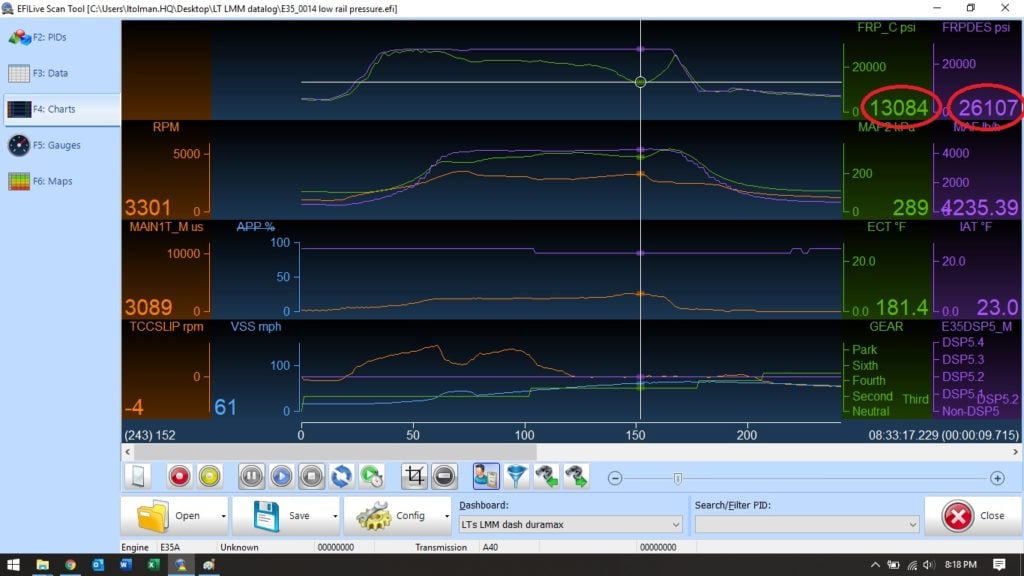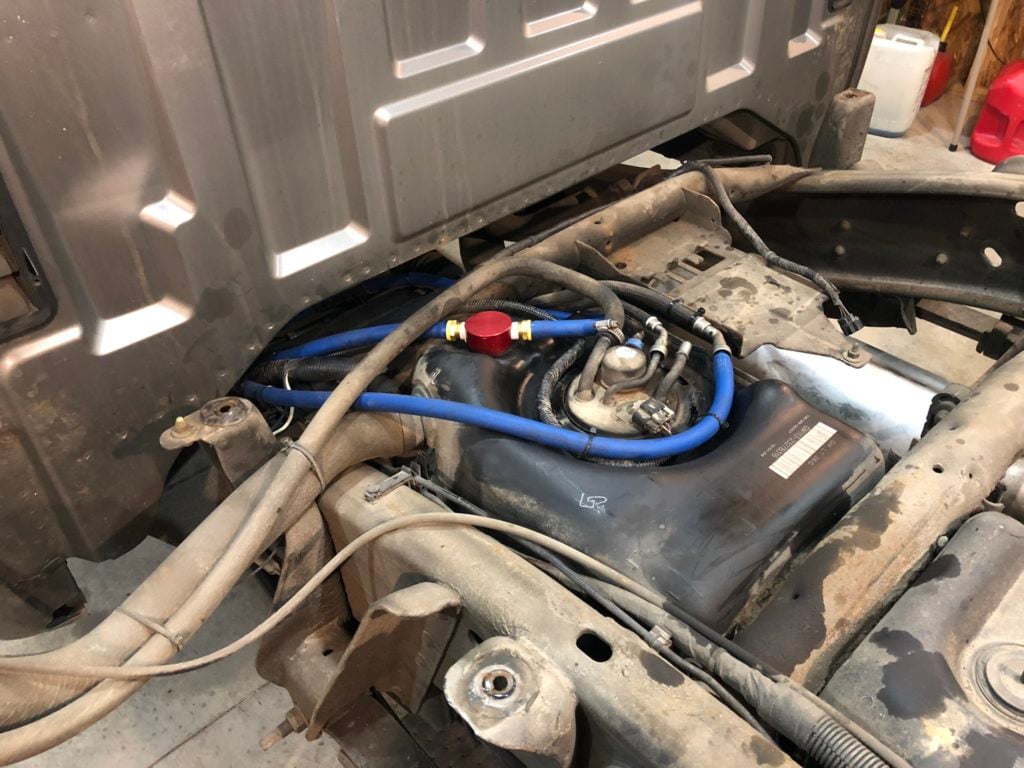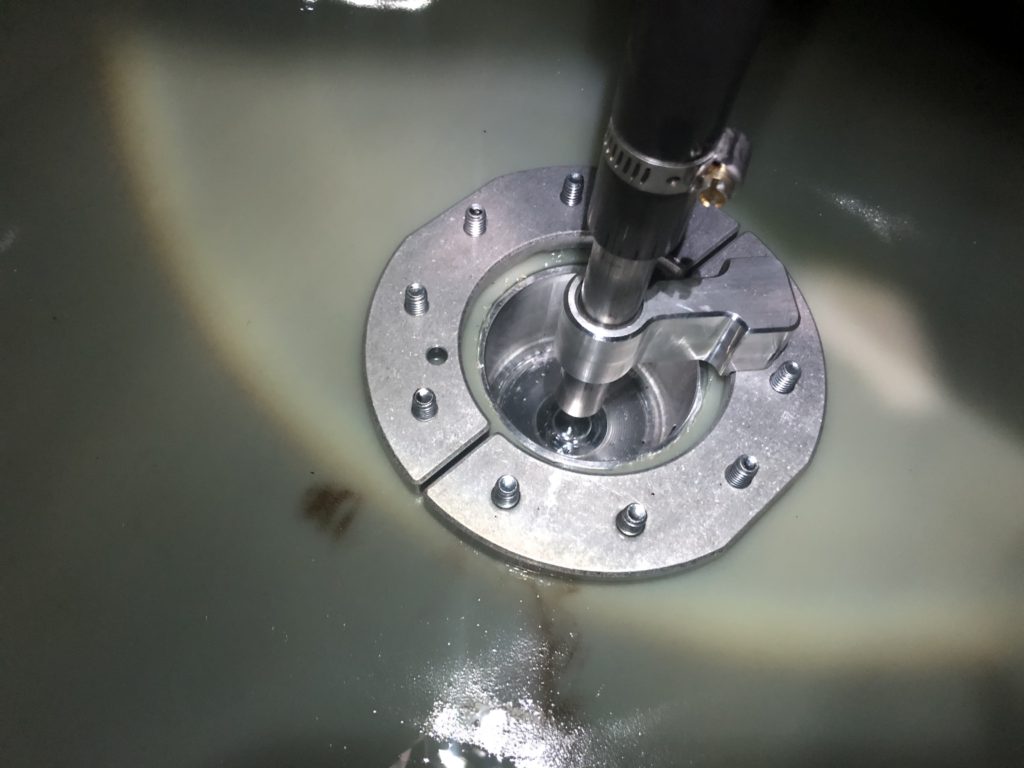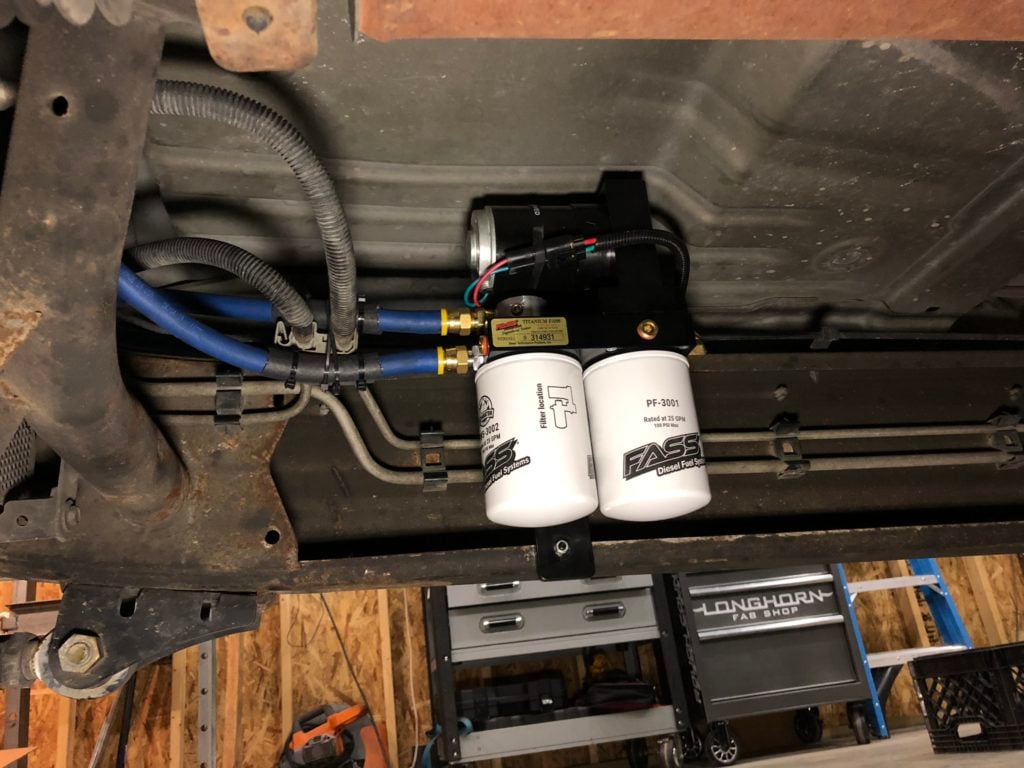2003 Chevy C4500 Reads Faster Mile Per Hour Than You're Actually Going
At that place are many not bad mysteries which have remained unsolved over the years, ranging from what's at the bottom of the Bermuda Triangle to what happened to D.B. Cooper and the money he took. While in that location have been several theories, to this day nobody knows the answer to either. I such automotive mystery was started in 2001, when GM introduced the Silverado Hard disk drive'southward powered by the 6.six-liter Duramax diesel V8. It was a great powerplant and was the first of the big 3 to come equipped with mutual rail fuel injection, but at that place was one item missing which every other diesel pickup had before and since: a elevator pump.
Diesel Organization Overview
There are many parts which make up the fuel system on a common rail diesel fuel truck, and the path the fuel takes is like a choose your own adventure book; there are many unlike options. It all starts in the tank, which is where the fuel is stored whenever yous make full. Depending on the model, you might have betwixt 25 and 40 gallons of capacity, and on most trucks there is a low-pressure fuel pump which sits inside the tank and pushes the fuel toward the engine at a relatively low pressure. Since diesel fuel by nature is a muddy product, there is always at least one filter between the depression-pressure pump and the engine to remove any dirt and contaminants, and likely there will be a h2o separator to remove whatever H2O which condenses in the tank. Side by side, the fuel enters the injection pump, where it tin can become one of two places: it either gets pressurized and sent to the track or goes back to the tank in a return line. Most of the high pressure level fuel within the rail gets sent straight into the injectors, but there are some conditions like sudden deceleration or a drop in fuel demand which volition crusade a pressure relief valve to open up and send excess fuel from the rail back to the tank. Finally, once the pressurized fuel enters the injector, it either gets sprayed directly into the cylinder to make a big smash, or if in that location is extra, it flows back to the tank through the injector return to offset its journeying all over again.
Every one of those components tin can be found on just about every diesel pickup made in the US for at to the lowest degree the last 20 years, whether it's an HEUI Powerstroke, a 12-valve Cummins, or even the old 6.5 GM Diesels. But for some strange reason, the vi.half-dozen Duramax came from the factory sans lift pump. The fuel takes the same path from the tank, through a filter, and into the injection pump, except now the CP3 is responsible for sucking fuel from the tank. This is true on every Duramax from the LB7 in 2001 to the LML in 2016. Interestingly enough, the five.9 and half dozen.seven Cummins trucks which were equipped with an virtually identical CP3 were equipped with a lift pump, and the newest L5P Duramax has one, all of which suggests a elevator pump is an important role of a diesel fuel organization. Even so the mystery remains, why didn't GM put one there in the first place.
You might exist thinking to yourself, "wait a minute, LT… there are plenty of Duramax'southward on the road with well over 200,000 miles and no elevator pump, and they don't seem to have any problems" and you would be partially correct. If you have a stock truck with no desire to add together horsepower, so sure, the engine can run fine without a lift pump for a long time. Just merely because it tin doesn't hateful it should. If you compare the CP3 in the Duramax to the CP3 in the Cummins, the one on the Duramax has to do a lot more work. Rather than having a constant supply of low pressure fuel at the inlet of the pump like on the Contrivance, the GM CP3 is required to generate enough suction to draw fuel from the tank at the same time it has to raise the fuel to a maximum of 27,000 PSI. If that'south non plenty, the CP3 has at least fifteen anxiety of line between itself and the fuel tank, with plenty of twists and turns which gives opportunity to create aeration in the fuel. Over time with the presence of vacuum, the condom lines tin can really collapse and cause a restriction, and if you add more horsepower, y'all increase the workload on the injection pump fifty-fifty more, and at a certain point, the CP3 only can't keep up whatsoever more.

High Power Blues
A well-documented problem on any Duramax whether it has the CP3 or 4, is a loss of rail pressure during acceleration once the truck has a college power tune on it, and I take experienced this myself many times. It can happen when taking off from a low-cal under medium throttle, flat footing the skinny pedal to pass the hay carriage taking up the whole lane, or on a sustained power run pulling a trailer upward a steep grade. Things will be going along just fine, when of a sudden it feels like you lifted your foot halfway off the get pedal. The rate of dispatch slows, and you might have a bank check engine light pop on with a P0087 lawmaking which ways the engine isn't getting enough high-pressure level fuel. If you happen to have a set of gauges, you'll notice the rail pressure isn't nearly equally loftier as it normally is, and if you investigate further by datalogging desired versus bodily fuel rails pressure level with a scan tool similar EFI Live, you'll notice a large departure betwixt the two. In my example, the truck was request for just over 26,000 PSI of fuel, but by the fourth dimension the engine got to 3,300 RPM the actual track force per unit area dropped to 13,000 PSI, which was HALF of what the ECM was commanding, severely limiting horsepower. This particular log was taken with the DSP switch in the 3rd tune which produces an additional ninety hp over stock, and the trouble becomes much more frequent on the higher settings, since the fuel demand goes upward with the hotter tunes.
If you feel a loss of rails force per unit area, at that place are a few possible causes. First, these symptoms can indicate a clogged fuel filter. Many commencement-time diesel truck owners recollect you need to modify a diesel filter at the same interval as a gas engine, merely in reality, information technology needs to be inverse much sooner. While a gas engine might make information technology 75k before a filter change, information technology should be common exercise to alter a Duramax fuel filter every 10,000 miles. As the filter clogs with dirt and droppings, fuel flow is impeded, and the pump tin't generate the desired pressure. So, to troubleshoot, simply swap out the old filter for a new one and run into if the problem goes abroad. In my instance, it didn't make any deviation in the low rail pressure, and then I had to proceed looking.
Next on the checklist is to thoroughly examine the fuel lines that run from the tank to the engine. They are fabricated partly from aluminum hard lines, and partly from nylon reinforced rubber hose. At that place are few places where the rubber hose makes a bend, specifically over the driver'south side valve embrace, another near the transmission underneath the truck, and a few more near the fuel tank. Pay special attention to the rubber hose around the bends, considering the suction from the injection pump can crusade the hose to collapse and pinch off the flow of fuel. Y'all may accept to remove the plastic corrugated protective sleeve from the hose, but if you are thorough, yous might be able to spot a complanate section. If so, it's not a huge bargain to replace the line, but in my example, everything was A.O.K. which meant my low runway pressure was nevertheless going to be an issue.
If you remember the basic fuel system beefcake, you'll recall at that place is a fuel pressure relief valve in the rail, and occasionally it can open up prematurely and cause low track force per unit area. The one way to spot an failing force per unit area relief valve it to burn down up your scan tool, recreate the symptom, and record some other data log. If yous meet a sharp sudden drib in runway force per unit area rather than a gradual refuse, your valve is popping off too soon, and it'due south an easy fix. Rather than replacing the valve with some other, just swap the valve for a force per unit area relief plug from ATS, and you'll never take to worry about the valve opening up once again. This will work for a race truck, but as well on a truck which spends its whole life on the street.

For myself, and many Duramax owners akin, none of those fixes would solve the curious case of the disappearing fuel rail pressure level, simply I knew at that place was 1 thing to arraign (or rather a lack of a thing). Call back that one part GM omitted from their fuel system? Well, equally information technology turns out, that missing pump does cause a few problems, which is why a lift pump is and then crucial.
Several Solutions
By installing an electric pump near the tank and pushing around ten psi of fuel to the injection pump, you take a lot of stress away from the CP3 (or 4) and allow it to focus on its main job of creating high pressure fuel, and that one unproblematic change tin can have multiple positive side effects. As usual, you do have a few choices on how to go a fuel pump into the mix, and the simplest and most price effective is the PPE Lift Pump. It installs just outside the tank, bolts to the frame rails, intercepts the stock suction line, and pushes the fuel on its way to the engine. Your stock filter head is retained, and no other modifications to the tank or residuum of the fuel system are required. Only plumb it in, wire information technology up, and your fuel arrangement will now be working to its total potential with no drop in rail pressure level under load. The pump flows 160 gallons of fuel per hour which volition keep upwards with the most demanding injection pump and functioning driving state of affairs. I elegant pump solution which is only available for the 2011+ LML trucks (for at present) is the Fleece PowerFlo in-tank elevator pump assembly. Information technology's past far the easiest to install and quietest lift pump out there, since the pumps sit down inside the fuel tank which insulates the noise. In that location are ZERO modifications required to the tank, lines, or fuel filler neck, and information technology will support 800-wheel horsepower. Plus, the OE design of the bucket the pumps sit in ensure the suction side will always be submerged, even if the tank is almost empty.
While fixing the fuel supply is a good starting time, a simple standalone lift pump does nothing to increase the filtration, and the fuel oil we love is pretty nasty stuff which often contains dirt, water, and other contaminants like air bubbles. The stock filter/water separator on a Duramax will remove particles downwards to about 10 microns in size, does an OK job of removing water, simply does cypher at all for the air that collects in the arrangement. If you lot are running a elevator pump and want cleaner fuel, y'all tin can swap to a larger and more than efficient Caterpillar 1R-0750 fuel filter which removes particles as small as ii microns. All you need to install it is an adapter kit from Sinister Diesel, but the Cat filter just addresses ane of the three contaminants in your fuel.

By installing a FASS Titanium Signature Serial pump you'll solve all the problems with a Duramax fuel arrangement in one vicious dive. The loftier efficiency FASS filters will now remove dirt particles downwardly to ii microns in size, the water separator takes out 99.96% of the water from the fuel, and the unique design of the pump too gets rid of any air that might be trapped, sending nothing merely the purest fuel upwardly to your injection pump and injectors. Also, because of the way the FASS return arrangement works, the fuel in the tank is constantly beingness cycled through the filters and will get cleaned several times, which helps your fuel system last a very long time. Of grade, the pump will back up more horsepower than stock, merely the enhanced filtration and refining of the fuel will lead to a smoother idle, longer injector and pump life, and even improves emissions output. Depending on your needs, yous tin cull a pump which flows anywhere from 95 gallons per hours (less than 600hp), all the manner upwards to a massive 290 gallons per hour which will support 1,500hp by itself. And the all-time part is, fifty-fifty the larger pumps are able to operate in low fuel demand weather, which ways your i,500hp truck can still be used equally a daily commuter and sit in traffic all solar day long (if you want to, that is).
Other Upgrades
You can install a FASS pump with the stock fuel suction line coming from the tank, but there are a few other upgrades you should install at the same time which will make for a more well-rounded and better working fuel system. A fuel tank sump does two things: allows a larger diameter suction tube to feed more volume to the lift pump and ensures the suction tube is e'er submerged in fuel. Besides, since the filters on the FASS system perform better in every manner, there'south no sense to keep the stock filter mounted up on the engine. A fuel filter delete kit will let yous to get rid of the bulky and expensive stock filter, and also gives you a location to mount a fuel pressure gauge sending unit.

Installation
If yous know me, you lot'll know I'm an advocate for people learning how to install parts on their ain, and a FASS system is a dandy place to start if you are just getting into diesel performance. All you demand are bones hand tools and a drill, and you tin complete the installation in ane mean solar day. On my 2008 LMM Duramax, I chose to install a Titanium Signature Series 165, forth with the FASS Sump/Suction Tube Kit which allowed me to pull fuel from the bottom of the tank with a loftier period ½" line without running any rubber hoses forth the lesser of the tank, which was important on a lowered 2wd street truck. Another benefit of their bulkhead fitting was information technology provided a port to run the FASS Mass Flow Return line into the tank without having to piece into the filler neck. The FASS kit does come with an adaptable bracket to mountain the pump from a bed bolt, but I chose to run a Wehrli Custom Fab bracket that places the pump on the inside of the frame, far abroad from any debris or h2o from the tires, and information technology keeps the pump hidden for a stealth expect. The very kickoff step to install a FASS was to bolt on the bracket and get the pump mounted, and the side by side step was to drill a few holes in the tank, but for easier access, I first removed the bed of the truck.
Once the fuel level sending unit/handbasket was removed from the tank, I marked and drilled a airplane pilot hole through the bottom of the tank and immune the fuel to drain into a clean v-gallon bucket. Simply make sure the hole isn't directly below the sending unit. And then, the pigsty is enlarged to 2-3/4" with a hole saw. Finally, using the sump as a guide, a series of ane/4″ holes are drilled around the perimeter, and some screws hold everything in place. Atop the tank, another hole is drilled, and the bulkhead plumbing equipment is installed with a nut holding it from the behind. Inside of the tank, the suction tube is connected betwixt the sump and bulkhead. Now, it's time to route the 1/2" fuel lines between the tank and the pump, and from the pump output to the stock suction line which now receives pressure. If the lines run near any sharp edges which might rub against them, it's good practice to protect the lines with some 5/8" heater hose which has been cutting lengthwise and slid over the fuel line. One time the plumbing is all done and hoses secured, the stock sending unit goes back in, the return line re-attached, and the bed can become back onto the truck. The very last step of the install is to attach the provided wiring harness to the battery and the fuse block, mountain the relay, and run the wires to the pump. Once everything is connected, prime the pump, check for leaks, and enjoy.

Totally Worth It
Once all the hard piece of work is done, what is the issue? For me, a subsequent data log with EFI Live confirmed exactly what the butt dyno suggested. Even with the DSP switch cranked up to four or 5, the rail pressure stayed exactly where the computer wanted it to be, the acceleration was restored, and of course all the side effects of a smoother and more than efficient running engine could be felt likewise, making for ane very satisfied customer. The mystery of why GM never installed a lift pump may never exist solved, only at least they best-selling the problem with the introduction of the L5P trucks in 2017. Now, all nosotros demand to effigy out is who killed Jimmy Hoffa…
Source: https://www.dieselpowerproducts.com/blog/why-the-duramax-never-had-a-lift-pump-and-why-it-shouldve/
Postar um comentário for "2003 Chevy C4500 Reads Faster Mile Per Hour Than You're Actually Going"